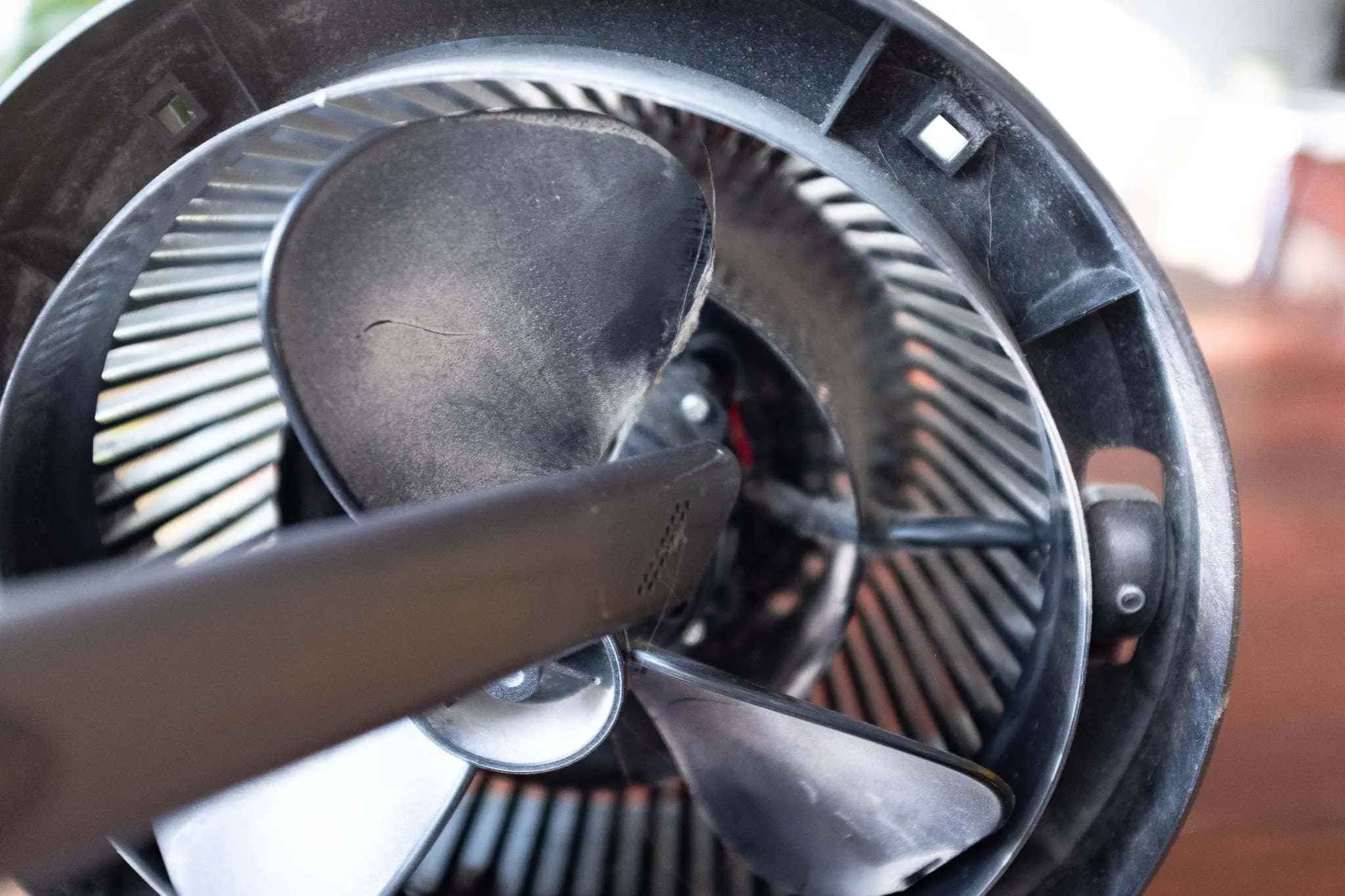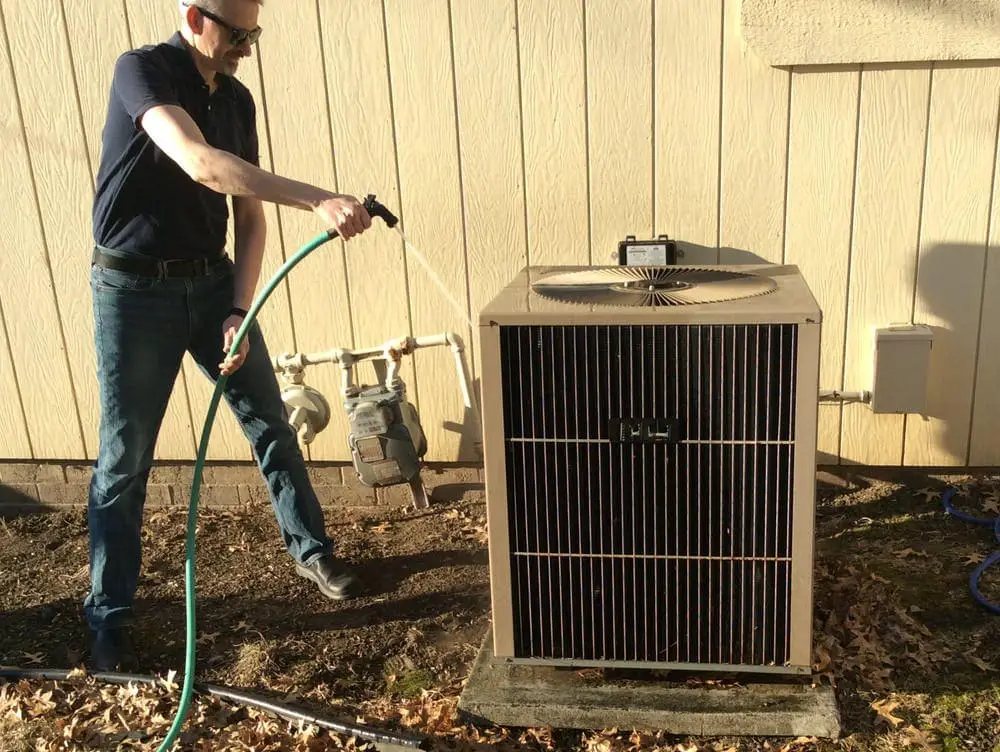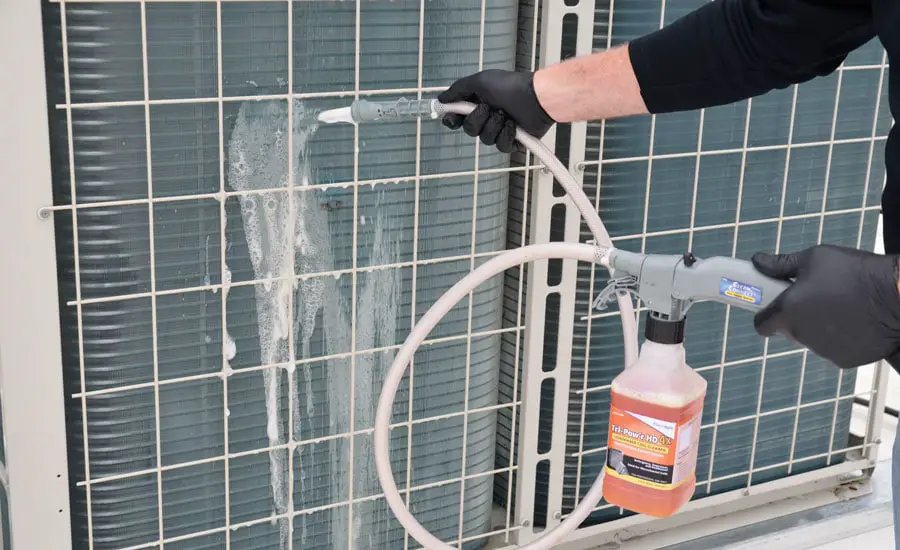You clean lots of things around your home to keep them working efficiently, from shower drains to ovens.
It’s easy to forget that your air conditioner needs regular cleaning too.
Cleaning the AC unit can seem daunting and complex. With the right tools and preparation though, it can be a breeze.

Photo credit: Simpsonsheetmetal.com
Project Metrics
To clean your AC, you need to understand what you’re dealing with. How difficult is the job? How long will it take you to complete? What items will you need to do the job properly, and how much will they cost?
Difficulty Level
Easy/moderate, depending on your preparation
Time to Complete
Roughly half a day
Material Cost
Moderate initial cost but can be utilized for other cleaning jobs
Items Needed to Clean an Air Conditioner
Before you can clean your air conditioner, you need the right equipment. Some you might already have around the house. Some are a little more specialized.
Tools to Clean an AC Unit
- 4-in-1 screwdriver – so you can easily get inside the casing and clean it out
- Fin comb – to clean the cooling fins. If at all possible, check the details of your unit and make sure you have the right size fin comb before you start
- Leather gloves – some of the insides of your AC unit are sharp and metal. Protect your hands
- Rags – the handyman’s best friend, great for rubbing in cleaning fluid
- Vacuum cleaner – handheld and cordless if you can, for flexibility and lightness
- A nylon-bristled brush, to work coil cleaner into the coils



Photo credit: Familyhandyman.com
Materials to Clean an AC Unit
- A/C coil cleaner – for the cleaning of AC coils. Get two cans from your local hardware store
- Electric motor oil – for tuning up your fan motor
- Household cleaner – for shiny, clean fan blades
Additional Useful Equipment to Clean an AC Unit
- A buddy, ideally with muscles. There will probably be some heavy lifting required
- A face mask if needed, or if you have breathing issues
How to Clean an Air Conditioner
Now you have the tools, and you have the materials, but do you have the talent to clean your AC unit yourself?
We’ll take you through two more accessible types of AC cleaning – a simple room AC unit, and a split-system AC unit. When it comes to the likes of central air, step away. Unless you are a professional, you’re best advised to call a professional.
Room AC
Getting Into The Unit
- Turn off the power to the AC. You’re going to be putting your hands inside a powerful piece of machinery. There will be sharp things, spinning things, and the potential of live power. Turn off the power to the AC to avoid any nasty shocks.
- Ensure you either have or take with you adequate lighting to see what you’re doing. Once you’ve turned the AC power off, the lights will go out.



Photo credit: mrright.in
Fin Combing
- Make a visual inspection of the cooling fins.
- Put on your leather gloves to protect your hands.
- Select the right size fin comb for your cooling fins.
- Use the fin comb to straighten any bent fins before cleaning.
Cleaning The Coils
- First, use your vacuum to suck up all the dust and particulates from the coils.
- Apply the coil cleaner thoroughly to both coils. Let it sit and work.
- If needed, rub the coil cleaner in with the nylon-bristled brush. Always go in the direction of the fins.
Polish The Fans
- Take off your leather gloves.
- While the coil cleaner does its work, take a rag and the household cleaner of your choice.
3. Rub the fan blades clean with your cleaning rag.
4. While you’re looking at the fan, check whether it has capped oiling ports. If it does, pop them off.
5. Add a few drops of electric motor oil to each of the oiling ports. Beware – this can be a fiddly job.
6. Replace the oiling port caps.
7. Check your air filter. If it looks like it needs it, give it a quick wash. If you have a spare, and it looks like it needs replacing instead, replace it while you’re here.



Photo credit: Nytimes.com
Putting It Back Together Again
- Once the coils are clean, the particulate build-up is vacuumed and the fan and motor assembly have been spruced up, it’s time to put it back together and back in place.
- Grab your buddy again. Promise them pizza if necessary.
- Lift the unit back into place with the help of your buddy.
- Re-screw any case screws you took out of the window case.
- Snap the plastic filter holder back on.
- While you’re here, take your rag and household cleaner and give the outside of the unit a clean.
Split-System AC
There are two sections you need to clean in any split-system AC unit – the inside and the outside. It doesn’t matter which you do first, you’re going to do them both before the day is out. But pick a side and skip to the relevant instructions.
Inside
Getting Into The Unit
- Turn off the power to the unit. As with room ACs, you don’t want any nasty electrical surprises while digging into the unit’s innards.
- As with the room AC, the plastic cover on a split-system AC should usually pop off with little effort. Here though, there are no screws to tackle.
- Locate the filter or filters. Likewise, these should easily pop out, like taking honeycombs out of hives.
Cleaning The Filters



Photo credit: Sharpairconditioning.com.au
- Ideally take the filters outside, where any loose dust or particulates can float away without landing on anything you have to eventually re-clean.
- Put on your face mask if you need one.
- Take your vacuum, and use the dusting brush head to get rid of any accumulated dust and grime.
- If the grime is heavy enough to warrant it, you can follow up by washing them in a solution of warm water and mild detergent.
- Ensure the filters are completely dry before putting them back in the unit.
Cleaning the Blades
- Check whether your unit’s oscillating blades are removable. If so, remove them.
- Either way, clean them with a dry rag, rather than using the household cleaner.
- Give the blades – and the space behind the blades – some attention with the vacuum. The chances are good that you’ll lift some previously unseen dust.
- If you’ve removed the blades, re-fit them.
Putting the Unit Back Together
- Remember – if you’re washed the filters, wait until they’re completely dry. Then return them to their position.
- Snap the plastic cover back on. Be gentle – this can actually be harder than taking it off, and frustration here could lead to annoying and potentially costly accidents.
Outside
Cleaning the outside of a split-system AC comes with a disclaimer. It’s mostly external maintenance because the internal mechanism is complex enough that it’s the borderline between what you can do yourself, and what you should call in a professional to do for you.
Clear The Area
- Make sure there are no overgrowing trees or bushes near the AC. They can drop leaves, dust, even small creatures into the system. Cut them back far enough that they never interfere with the AC’s operation.



Photo credit: theconversation.com
2. This is when having a cordless vacuum comes into its own. Vacuum the outside of the AC, the slats, and whatever you can safely reach, to clear it off as much dust and debris as possible.
3. Don’t be a hero. This is where you call in the professionals. Going in on your own could result in damage and the added cost of a new AC unit.
4. If you have an outside condenser, you can still give it a wash-down with a pressure hose, but be careful. Don’t use too much pressure, as that could bend your coil fins, and always turn off the thermostat before you start washing.
How Often Should I Clean My Air Conditioner?
There’s no single answer to this question, because of the variety of AC units available, and the different cleaning needs of different parts of each AC.
Overall, cleaning your filters every month or so is a good plan, (more frequently if you live in dusty regions), while the coils could stand six months to a year between cleaning.
External AC elements, more open to dirt, rain, or dust, should probably get a vacuum and/or a wash-down every month to two months. Bottom line, the more you use the AC, the more regularly you need to clean it.
Think of cleaning your AC as part of its between-service maintenance. The cleaner your AC is, the better it will be likely to run, and the cooler you’ll stay.
Tips and Safety Considerations When Cleaning Air Conditioner
- Never clean an AC unit that still has power going to it. This is the equivalent of cleaning an oven with the burners on. You can do it, but it’s unnecessarily dangerous and more than a little dumb. Always disconnect before you start dismantling and cleaning an AC unit.
- Take protection seriously. If you’re going to be straightening or scrubbing a whole lot of fins, get yourself some leather gloves to protect yourself from jabs and potential gashes.
- Likewise, if you’re cleaning a lot of dust and particulates off your filters or coils, use a dust mask. You don’t know what that dust is made of, or how it might affect your breathing. If you have breathing issues anyway, keep the mask on throughout coil-cleaning, because chemical inhalation can be an issue.
Doing it on your own when you’re not prepared for the weight could lead to a ruined AC unit if you drop it, or to serious injury, if you drop it on yourself.



There’s no physical risk to not doing this, but the risk to your mental equilibrium when you’ve spent three times as long looking for a single screw as it took you to clean the entire AC unit is not something your family or pets would want you to overlook.
Conclusion
Cleaning your AC unit need not be a big and daunting job. All you need is an understanding of what you can do yourself, and when it’s time to call in professionals, a small amount of equipment, and some cleaning products.
And possibly a handy, step-by-step guide and some Youtube videos.
People Also Ask
The world is full of different types of AC units, from room ACs to split-system ACs, to central air. It’s no surprise then that people have questions that cover the waterfront of AC cleaning.
Let’s deal with a few of the most common questions people have before cleaning their AC units.
Is It Ok To Spray Water on Your Air Conditioner?
The answer to this depends on a few factors. Is your AC inside? If so, we’d advise against it – though you can wash your filters gently in the water, so long as you make sure they’re fully dry before replacing them.
If you have an outside AC, you can use a pressure hose to rinse down the fins, but be careful not to use too much pressure.
Above all, whatever else you do, always turn off the power to your AC before you clean it. That goes double if you’re going to spray water on it.



Photo credit: achrnews.com
Can I Clean My AC Coils Myself?
Again, you can do it, but the wisdom of doing it depends on the kind of AC unit you have. With a small room AC, yes, you’re safe to do that.
The bigger and more complex the AC, the less advisable it becomes to try to clean the coils yourself.
Which Chemicals Are Used For AC Cleaning?
If you’re doing it yourself, then you’re looking at mostly household cleaning fluids and detergents, with usually a couple of cans of commercial coil cleaner.
Commercial coil cleaners, available at hardware stores, usually include the likes of potassium or sodium hydroxides. It’s worth using gloves and a mask when using them, just to be safe.
How Much Does It Cost To Have Your Air Conditioner Cleaned?
Again, the reason this is a question at all is that there is a great deal of variety in the answers – not only depending on what kind of AC unit you have, how difficult it is to access, etc.
There are also regional price differences, service levels, and the like. Prices and quotes vary from a minimum of $70 to a national average of around $125 for indoor AC units, and upward to a national average of $250 for an evaporator coil cleaning.
